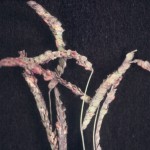Dallisgrass Ergot
Claviceps paspali
Poaceae
Description
Dallisgrass (Paspalum dilatatum) seed heads are often infected with the fungus Claviceps paspali. Fungal spores germinate in the flower, grow in the premature seed and produce honeydew that is transferred to other seed heads by insects. In an infected flower, a fungal body or sclerotium forms instead of a seed. The sclerotium is round and up to 1/8 inch across with a cream-colored center. Its outer coat may vary from white to orange, red, or black because of other fungi growing on the ergot body. Many seed heads include normal seed, honeydew, and sclerotia. This fungus also infects and produces toxins in other Paspalum species such as Brownseed Paspalum and Bahiagrass. Dallisgrass (Paspalum dilatatum) is a perennial, warm-season, introduced grass species ranging from 12 to 48 inches or 30 to 122 cm tall. Good grazing for livestock. Fair grazing for wildlife. Seedheads can become covered with a sticky "honey dew" that can cause ergot poisoning in cattle.Habitat
Dallisgrass may be found in all areas of Texas, but widespread ergot infection is usually limited to the eastern half of the state. The high humidity and soil moisture required for ergot production also occur in limited areas along streams and in canyon floors in west central and West Texas.Toxic Agent
Sclerotia on Paspalum grasses contain paspalitrems, termorgenic mycotoxins responsible for dallisgrass staggers. Most cattle poisonings result when the cattle eat mature seed heads in the pasture; calves are known to selectively eat seed heads with honeydew. Horses are not usually poisoned unless they consume Paspalum hay that contains ergot.Signs of Livestock Ingestion
Poisoned cattle and horses demonstrate similar signs, including: Hyperexcitability; Uncontrollable muscular tremors; Incoordination; Falling when forced to exercise; Inability to regain feet. Cattle usually recover when they are removed from ergotized pastures unless there is misadventure, such as falling headlong into water or limb breakage, or if they go down in the sun and die of exposure or lack of water. Horses with nervous ergotism tend to be destructive, often injuring themselves, sometimes requiring euthanasia.Management Strategies
To treat nervous ergotism, remove the source from the animal's diet. Some severely poisoned horses have recovered after a few days in a padded surgical recovery room. Cattle almost always recover if they are moved to shade, fed, and watered. To prevent poisoning, managers must be able to recognize ergot-infected seed heads and prevent livestock from consuming them. Remove the seed heads by mowing before cutting for hay or grazing the pasture. If grazing is continuous, most seed heads are consumed before the toxin is produced. Unrolling potentially hazardous round bales can leave many of the ergot bodies on the ground, where animals are less likely to eat them.Images
Plant Characteristics
Seed Type: Non-Encapsulated
Duration: Perennial
Stem Texture: Hairless/Smooth
Growth Habit: Grasses
Leaf Shape
 : Simple with Pinnate or Parallel Venation
: Simple with Pinnate or Parallel Venation
Season: Warm
Distribution
 : 01 - Pineywoods, 02 - Gulf Prairies and Marshes, 03 - Post Oak Savannah, 04 - Blackland Prairies, 05 - Cross Timbers and Prairies, 06 - South Texas Plains, 07 - Edwards Plateau, 08 - Rolling Plains, 09 - High Plains, 10 - Trans-Pecos
: 01 - Pineywoods, 02 - Gulf Prairies and Marshes, 03 - Post Oak Savannah, 04 - Blackland Prairies, 05 - Cross Timbers and Prairies, 06 - South Texas Plains, 07 - Edwards Plateau, 08 - Rolling Plains, 09 - High Plains, 10 - Trans-Pecos
Distributions
Distribution refers to the ecological region in Texas that a plant has been found. You can also view a clickable map.
Book: Toxic Plants of Texas (B-6105)
Collection: Toxics
Livestock Affected: Cattle, Horses
Livestock Signs: Collapse, Convulsions, Excitability, Incoordination, Running Into Objects, Unable To Rise




